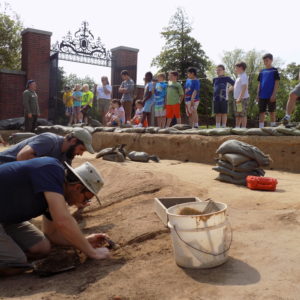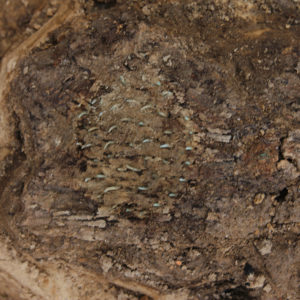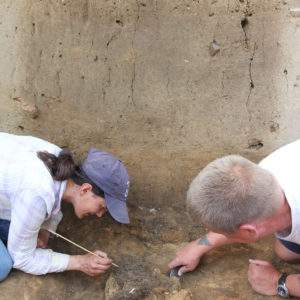The story of books from early Jamestown may have a new chapter.
Twenty years of excavations at the James Fort site have yielded more than 100 pieces of book hardware. But they are just that: artifacts made from copper alloy that were both functional and ornamental components once attached to books. The paper and other book parts long ago disintegrated in the soil.
This month the Jamestown Rediscovery archaeologists may have found part of a wooden book cover, preserved by the copper tacks embedded in it.
The artifact came from the cellar that the archaeologists are currently excavating near the Preservation Virginia entrance gate and just north of the 1907 Memorial Church. This spring they have been working in the southeast quarter of the circular feature. Staff Archaeologist Mary Anna Richardson said most the artifacts found this month are from the latter stages of the James Fort period – the 1610s. They have found lead shot and waste from making lead shot, strap buckles, trade beads, seals that relate to the import of cloth to the colony, and large iron objects including pieces of armor and a mangled breastplate.
“While excavating around an iron object to prepare it for removal, I clipped the edge to something holding several copper tacks in place. After I removed some more of the soil around the tacks, I realized that they were attached to the remnants of a flat piece of wood,” she said. “Once the limits of the wood were fully exposed, you could clearly observe a cluster of tacks in the center of the wood forming a circular pattern.”
Before she found the wood fragment with tacks, the archaeologists had found almost two dozen of the same kind of tacks scattered in the soil nearby. The copper tacks contain salts which kill the bacteria in the soil that would normally eat up the wood, said Senior Conservator Dan Gamble.
The wood fragment could be from a buckler, a small shield used by a soldier when swordfighting. Or it could be the lid to a wooden box. But some books of the era did have wooden covers and ornate hardware to protect the pages from damage. Book hardware came into use during the 14th century in Europe and was still in use in the early 17th century when the colonists arrived at Jamestown. Wood board book covers are usually one inch in thickness and generally date to before 1570, when paste or paper board was introduced for covers, said Merry Outlaw, Curator of Collections for Jamestown Rediscovery.
The archaeologists pedestaled the find, which means they wrapped it with about two inches of its supporting soil to transport it into the lab for more careful excavation. Conservators sprayed the wood and tacks with Rhoplex to protect the artifact from further deterioration in the air, then wrapped the artifact in cheesecloth. In early June, Gamble will attempt to remove the artifact from the section of soil (which also still contains a sturgeon scute and an iron object).
“Right now it’s too big a section to x-ray,” Gamble said. “There are probably other artifacts underneath it as well.”
This May find is well-timed: Gamble spent the past winter conserving and researching artifacts associated with early modern European books. The types of book hardware found previously at Jamestown include numerous copper alloy book clasps and catch plates. Many of these artifacts are stamped with motifs that may help to trace what type of book they adorned. Hardware was used on books ranging from bibles and devotional books to medical books and travel books.
Some of the book hardware from James Fort’s early archaeological contexts may relate to the library lost by the first reverend at Jamestown, Robert Hunt, during a fire that consumed the majority of the fort in early January of 1608.
related images
- Archaeologists excavating the box or book cover









